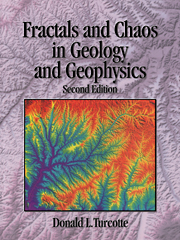Book contents
- Frontmatter
- Contents
- Preface
- Preface to the second edition
- 1 Scale invariance
- 2 Definition of a fractal set
- 3 Fragmentation
- 4 Seismicity and tectonics
- 5 Ore grade and tonnage
- 6 Fractal clustering
- 7 Self-affine fractals
- 8 Geomorphology
- 9 Dynamical systems
- 10 Logistic map
- 11 Slider-block models
- 12 Lorenz equations
- 13 Is mantle convection chaotic?
- 14 Rikitake dynamo
- 15 Renormalization group method
- 16 Self-organized criticality
- 17 Where do we stand?
- References
- Appendix A Glossary of terms
- Appendix B Units and symbols
- Answers to selected problems
- Index
4 - Seismicity and tectonics
Published online by Cambridge University Press: 05 June 2012
- Frontmatter
- Contents
- Preface
- Preface to the second edition
- 1 Scale invariance
- 2 Definition of a fractal set
- 3 Fragmentation
- 4 Seismicity and tectonics
- 5 Ore grade and tonnage
- 6 Fractal clustering
- 7 Self-affine fractals
- 8 Geomorphology
- 9 Dynamical systems
- 10 Logistic map
- 11 Slider-block models
- 12 Lorenz equations
- 13 Is mantle convection chaotic?
- 14 Rikitake dynamo
- 15 Renormalization group method
- 16 Self-organized criticality
- 17 Where do we stand?
- References
- Appendix A Glossary of terms
- Appendix B Units and symbols
- Answers to selected problems
- Index
Summary
Seismicity
A variety of tectonic processes are responsible for the creation of topography. These include discontinuous processes such as displacements on faults and continuous processes such as folding. Tectonic processes are extremely complex but they satisfy fractal statistics. Earthquakes are of particular concern because of the serious hazard they present; earthquakes also satisfy fractal statistics in a variety of ways. Seismicity is a classic example of a complex phenomenon that can be quantified using fractal concepts (Turcotte, 1993, 1994a, 1995).
According to plate tectonic theory, crustal deformation takes place at the boundaries between the major surface plates. In the idealized plate tectonic model plate boundaries are spreading centers (ocean ridges), subduction zones (ocean trenches), and transform faults (such as the San Andreas fault in California). Relative displacements at subduction zones and transform faults would occur on well-defined faults. Displacements across these faults would be associated with great earthquakes such as the 1906 San Francisco earthquake. However, crustal deformation is more complex and is usually associated with relatively broad zones of deformation. Take the western United States as an example: Although the San Andreas fault is the primary boundary between the Pacific and the North American plates, significant deformation takes place as far east as the Wasatch Front in Utah and the Rio Grande Graben in New Mexico. Active tectonics is occurring throughout the western United States. Distributed seismicity is associated with this mountain building. Even the displacements associated with the San Andreas fault system are distributed over many faults.
- Type
- Chapter
- Information
- Fractals and Chaos in Geology and Geophysics , pp. 56 - 80Publisher: Cambridge University PressPrint publication year: 1997
- 2
- Cited by



